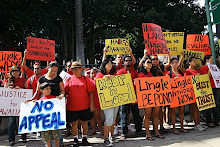Today, the law school had a packed room for a debate between Ilya Shapiro and Prof. Carl Christensen. Ilya Shapiro appears to be in town because he is touring California and Hawaii giving presentations. Anyway, the law school classroom was crowded with law school students, faculty, and a good number of visitors not affiliated with the law school in anyway. For example Aunty Leona Kalima was present. For those of you who don't know, Aunty Leona Kalima was a plaintiff in a lawsuit that sought to protect land claims for Native Hawaiians. Click here to read a Star-Bulletin article on the suit when the Hawaii Supreme Court found in favor of Native Hawaiian claimants. Video is available below.
Also in attendance were people who oppose Native Hawaiian programs, claims, and rights such as:
- Bill Burgess
- David Rosen
- Grassroot Institute
A few hours after speaking with some law students, it seems as though the consensus is that Prof. Carl Christensen won the debate. Others have commented that Ilya Shapiro appeared condescending and as a result, it was difficult to want to agree with him. You'll notice in the video above that there are times when Ilya looks up into the air while he's talking and some seem to have interpreted this behavior as though Shapiro thought this was a topic not worth real discussion. Shapiro may have lost some credibility with the audience when he was talking about Hawaiian history and the Hawaiian Kingdom, but couldn't remember the name of Hawai'i's last Queen. Some members of the audience afterwards thought that someone who professes to be familiar with these local issues should at least be familiar with the history that give rise to these issues.
Ilya expressed the idea that to be Native Hawaiian, one must be 50% or more Native Hawaiian by blood or have a Hawaiian last name. A number of audience members had very little, if any at all, appreciation for this definition of Native Hawaiian. What may have been puzzling to many in attendance is that, a person, who does not appear to have ever lived in Hawaii and who does not currently live in Hawaii somehow feels he is in a position to define what a Native Hawaiian is or is not.
Professor Carl Christensen, immediately upon arriving at the lectern, clarified that the issues raised by Ilya have no place in this debate specifically because those 14th amendment issues have not been raised by the Lingle Administration nor the Office of Hawaiian Affairs. As such, the U.S. Supreme Court is not being asked whether or not programs benefitting Native Hawaiians discriminate on the basis of race. The only question that the Lingle Administration has asked the United States Supreme Court is basically, did the 1993 Apology Resolution, passed by the 103rd Congress, prevent the State of Hawai’i from selling ceded lands?” Somehow, Ilya seems to think it was appropriate to raise issues in this debate that the Supreme Court has not been asked by any of the disputing parties (Lingle Administration or OHA).
Unfortunately, we had some issues with one of our video cameras. You may have been able to tell from our video-stream that the camera on the left, at times, had better (louder) audio, but sometimes had some “weird” imagery like: shaking camera, cartoon-type curtains, words like “STAMINA” across the middle of the screen. We were not sure exactly what was happening with that video camera. We later realized that it was on “DEMO” mode. As we review the video now, we remember that there were times when the left video camera kept turning off unexpectedly. When we were recording-livestreaming and we noticed that the left-side video camera unexpectedly turned off, we immediately had to transfer to the right side video camera and unfortunately, there were times when Ilya’s comments were inadvertently interrupted. You can tell all the time on the video, but when this happened in real time, the screen went black. This pre-recording that you’re watching now however, doesn’t show that, instead it just skips to the next footage, and gives the appearance of blending one camera to another. Around 39:55 minutes or so, I realize now, (hours after the live-stream) that audio may not be heard. If there is a way to fix this, we will work towards doing that. Interestingly enough, we didn’t get any complaints via e-mail about internet viewers not being able to hear the audio.
We’ll be sure to work on these “bugs” for next time. For the most part, we'll let you develop your own opinion and hope you find the video useful. Thank you for visiting.




No comments:
Post a Comment